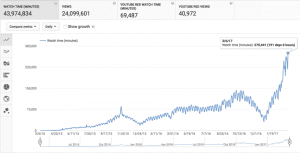With more than one billion users—or nearly one-third of all internet users—YouTube is a cultural (and marketing) force to be reckoned with.
Each day YouTubers view a billion hours of video. And it isn’t just cat videos getting all the attention.
So if your brand is utilizing YouTube as a part of your social media strategy, how do you enhance your chances of getting your videos seen?
Step one is knowing the YouTube algorithm.
What’s the YouTube Algorithm?
The YouTube algorithm is the computerized system that determines which videos people view when they are on the website. Like the algorithms developed by Facebook, Instagram, and other social media websites, it is all about showing users what they want (or at least what the algorithm thinks they want).
With over 400 hours of video uploaded every minute, YouTube needs a method to automate the selection of videos that surface to each user.
The YouTube algorithm—their “search and discovery system”—won’t only decide which results in visitors see once they search on the site, however, it also determines which ones they will be shown in other sections of the site.
There are 6 key places where the algorithm impacts where your videos could appear: in search outcomes, the suggested videos stream, on the home page, the trending stream, under the viewer’s subscriptions, and through any notifications, they have set up.
YouTube is open about the goal of their algorithm: “The targets of YouTube’s search and discovery system are twofold: help viewers find the videos they want to see and maximize long-term viewer engagement and satisfaction.”
But if that is the stated point of the algorithm, how does it accomplish that purpose?
What we know about how the YouTube algorithm works
Originally the only factor the YouTube algorithm paid attention to in determining which videos would get a better ranking than others was the total number of times anybody clicked “play” on a video.
However, views only showed the number of times a video player loaded, rewarding creators whose videos got lots of clicks—regardless of how long the viewer watched. Creators began adding spammy descriptions of thumbnails, generating clicks and getting better rankings, however, not keeping viewers engaged.
So in 2012, YouTube changed their ranking algorithm to reward engagement instead of clicks by dropping views in favor of watch time—a more accurate measure of how engaging users find a video.
How does YouTube determine the algorithm?
Remarkably, YouTube has shared—through an academic paper from 2016—the basic architecture of the system it depends on to decide which videos to show a user once they land on the site.
When you are a computer scientist, the analysis paper goes into great depth. Otherwise, the key factor to remember is that YouTube is not in the business of judging whether your video is “good” or not.
Instead, the YouTube ranking algorithm focuses on how the viewers interact with videos, utilizing artificial intelligence that “learns from over 80 billion bits of feedback from the viewers every day to understand serve the right videos to the right viewers at the right time.”
In broad terms, that viewers feedback contains:
- What they do (and don’t) watch
- How much time they spend watching a video (watch time)
- How much time they spend watching videos during each visit (session time)
- Likes, dislikes, and ‘not ’ feedback
Watch time
Once YouTube decided to mothball the view metric, it replaced it with “watch time,” or how long an audience watches a video. Not only are individual videos ranked by watch time, but so are your channels, according to YouTube: “Channels and videos with higher watch times are likely to show up higher in search results and recommendations.”
However, do not be fooled into thinking that enhancing your watch time is as simple as creating longer videos. A 30-second video that people watch from start to finish will rank better than a 10-minute video that only gets watched for a couple of minutes. In the end, the best way to boost watch time is to produce videos your viewers want to watch.
Watch sessions
Keep in mind how one of the targets of the YouTube algorithm is to maximize long-term viewer engagement? It also ranks videos based on how they contribute to that purpose, says YouTube. “If a video on your brand’s channel drives [n audience] to watch more videos, the channel earns some watch time credits for the cumulative minutes accrued. ”
That last bit is telling: YouTube is not concentrated on getting people to watch your videos. They just want them to watch more videos and spend more time on the site.
Improve your organic reach on YouTube
Given what we learn about how the YouTube algorithm works, what levers could you pull to enhance your ranking and your organic reach on YouTube?
Tweak your YouTube SEO
Before you could enhance your watch time and bump your videos’ ranking, you should be found in the first place, particularly when people search the site. That takes some basic YouTube SEO. YouTube provides creators control over the key info its search engine relies on to know what a specific video is about, including titles, tags, and descriptions.
Make sure that the copy you utilize is compelling, to the point, and accurately conveys what the video is about—and what the audience will gain or learn from watching it. There is no sense getting spammy with keyword stuffing: When you fool people into clicking on your video and they bail after the first few minutes you are only hurting your ranking.
Getting viewers to pick your videos
Once your video is presented to the users, the next step to enhancing your organic reach and ranking is to get them to click on the video. That is where creative and attractive thumbnails come in. Use an arresting picture and text—however, make sure that it really represents what’s in the video.
Keep them watching
Once somebody clicks on a video, you should keep them watching. The longer you could keep them watching, the more the algorithm will surface your content. So do what you could to hook the viewer rapidly by explaining the advantages of watching the video. Also, experiment with tactics to convince them to look at all the way to the finish, maybe by letting them know from the beginning about any special info you will be sharing at the end.
Get more loyal subscribers
Tubefilter says one element that can increase your ranking is view velocity—how many subscribers watch your video in the first couple of days after it is published. The more subscribers you have—and the more active they’re—the better your chances at ranking higher than competing videos. That is where working hard to grow your YouTube subscriber count could really pay off.
Build on the power of playlists
Anybody who’s lost a whole night (or weekend) to binge-watching their favorite Netflix series knows the power of being served up natural followup as soon as you finish watching the first video. Playlists drive higher content consumption, keeps subscribers hooked, and could increase your watch time. Instead of making miscellaneous playlists, bundle videos targeted at the similar viewers.
Keep in mind that you could get rewarded for session time even when an audience moves on to someone else’s video. So when you have a limited number of videos on one subject, experiment with adding videos from a non-competing source to your playlist.
Learn from YouTube analytics
YouTube gives detailed analytics that allows you to measure the performance of your videos, playlists, and channels. Pay attention to which videos get the highest watch times and attempt to understand why they appeal to your viewers. As you get more familiar with which kinds of videos perform well, take a look at your history and begin setting goals for watch time, views, and subscriber for the next month.
A single poor performing video could drag down the ranking of your entire channel, so do not hold on to losing content. Refresh, redo, or replace the stragglers with better videos, based on what you could glean from YouTube analytics.


